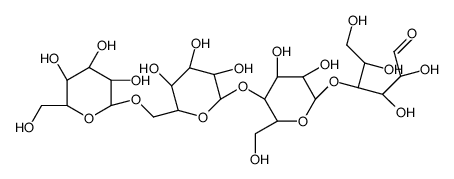Glucose tetrasaccharide

Glucose tetrasaccharide structure
|
Common Name | Glucose tetrasaccharide | ||
|---|---|---|---|---|
| CAS Number | 35175-16-7 | Molecular Weight | 666.57800 | |
| Density | 1.79g/cm3 | Boiling Point | 1112.9ºC at 760mmHg | |
| Molecular Formula | C24H42O21 | Melting Point | N/A | |
| MSDS | Chinese USA | Flash Point | 359.9ºC | |
|
Unique oligosaccharide (apparently glucotetrasaccharide) in urine of patients with glycogen storage diseases.
Clin. Chem. 36(7) , 1381, (1990)
|
|
|
Long-term monitoring of patients with infantile-onset Pompe disease on enzyme replacement therapy using a urinary glucose tetrasaccharide biomarker.
Genet. Med. 11 , 536-541, (2009) To investigate the correlation of the urinary glucose tetrasaccharide, Glcalpha1-6Glcalpha1-4Glcalpha1-4Glc, (Glc4) with skeletal muscle glycogen content and the long-term clinical response to enzyme replacement therapy with recombinant human acid alpha gluco... |
|
|
Assessing disease severity in Pompe disease: the roles of a urinary glucose tetrasaccharide biomarker and imaging techniques.
Am. J. Med. Genet. C. Semin. Med. Genet. 160 , 50-58, (2012) Defining disease severity in patients with Pompe disease is important for prognosis and monitoring the response to therapies. Current approaches include qualitative and quantitative assessments of the disease burden, and clinical measures of the impact of the... |
|
|
Liquid chromatographic assay for a glucose tetrasaccharide, a putative biomarker for the diagnosis of Pompe disease.
Anal. Biochem. 287 , 136-143, (2000) A HPLC method associated with butyl-p-aminobenzoate derivatization has been developed for the analysis of a tetraglucose oligomer, Glcalpha1-6Glcalpha1-4Glcalpha1-4Glc, designated Glc(4), in biological fluids. This tetraglucose, normally excreted in the urine... |
|
|
Urine analysis of glucose tetrasaccharide by HPLC; a useful marker for the investigation of patients with Pompe and other glycogen storage diseases.
J. Inherit. Metab. Dis. 35(2) , 311-6, (2011) A high performance liquid chromatography method, adapted from an established urinary sugars method, has been developed for the analysis of a tetraglucose oligomer (Glc(4)) in urine. Pompe disease results from defects in the activity of lysosomal acid α-glucos... |
|
|
Successful immune tolerance induction to enzyme replacement therapy in CRIM-negative infantile Pompe disease.
Genet. Med. 14(1) , 135-42, (2012) Infantile Pompe disease resulting from a deficiency of lysosomal acid α-glucosidase (GAA) requires enzyme replacement therapy (ERT) with recombinant human GAA (rhGAA). Cross-reactive immunologic material negative (CRIM-negative) Pompe patients develop high-ti... |
|
|
Analysis of a glucose-containing tetrasaccharide by high-performance liquid affinity chromatography.
Anal. Biochem. 182(1) , 48-53, (1989) In the present work we have explored conditions for using a pulsed amperometric detector for on-line analysis of oligosaccharides eluted from a high-performance liquid affinity chromatography column. A monoclonal antibody that specifically binds a glucose-con... |
|
|
Serum anti-Glc(alpha1,4)Glc(alpha) antibodies as a biomarker for relapsing-remitting multiple sclerosis.
J. Neurol. Sci. 244(1-2) , 59-68, (2006) There is an unmet need to develop specific biomarkers for multiple sclerosis (MS) to aid in the diagnosis, improve the management of patients and the monitoring of the effectiveness of treatment. We have screened serum from patients with relapsing-remitting M... |
|
|
Determination of a glucose-containing tetrasaccharide in urine by radioimmunoassay.
J. Immunol. Methods 48(1) , 109-19, (1982) A radioimmunoassay is described that allows rapid determination of a urinary oligosaccharide -- Glc alpha 1-6Glc alpha 1-4Glc alpha 1-4Glc [(Glc)4] -- at concentrations greater than 2 pmol/microliter. Antibodies produced in rabbits immunized with the phenethy... |
|
|
Glucose tetrasaccharide as a biomarker for monitoring the therapeutic response to enzyme replacement therapy for Pompe disease.
Mol. Genet. Metab. 85(4) , 247-54, (2005) A tetraglucose oligomer, Glcalpha1-6Glcalpha1-4Glcalpha1-4Glc, designated Glc4, has been shown to be a putative biomarker for the diagnosis of Pompe disease. The purpose of this study was to assess whether Glc4 could be used to monitor the therapeutic respons... |